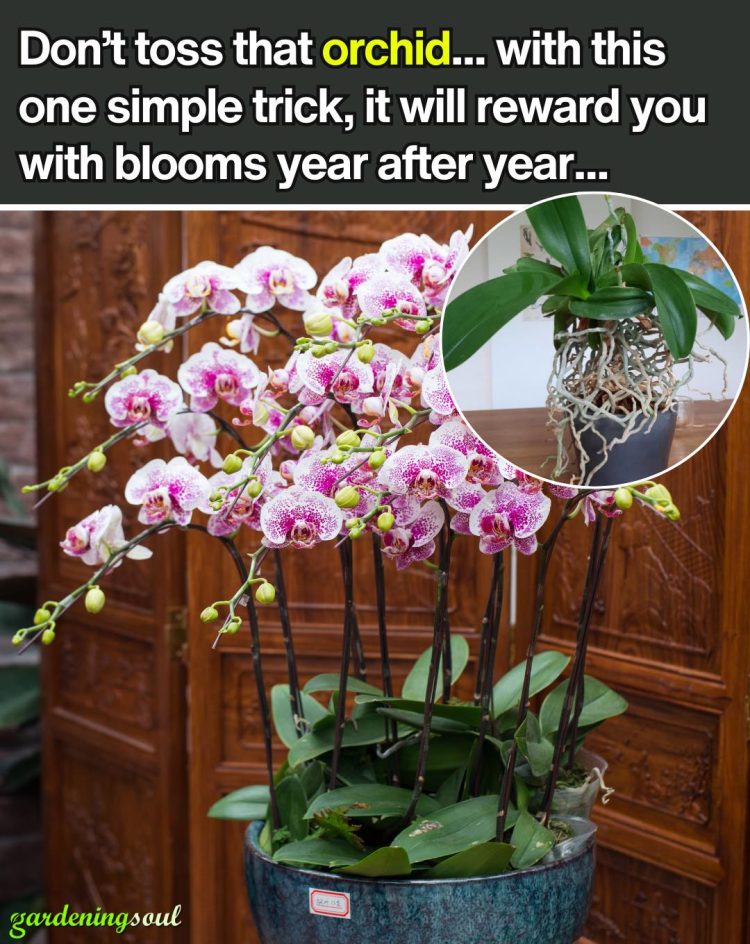When a new spike emerges, usually from the base of the plant between the leaves, it begins as a small nub that gradually elongates.
This is a crucial stage, and the plant needs steady conditions. Provide consistent water, regular fertilization, and strong but indirect light.
As the spike grows taller, it will eventually need support to prevent bending or snapping. Insert a slender stake into the potting medium and loosely tie the spike with soft clips or plant ties.
Avoid anything too tight, as you don’t want to damage the stem. Supporting the spike ensures the developing flowers will be held upright and displayed beautifully once they open.
Step 7: Return to Blooming Care
Once buds begin to form along the spike, your orchid has successfully transitioned back into the blooming phase.
This is the time to maintain even moisture – don’t let the roots dry out completely, but also don’t water so much that the potting medium stays soggy. Fertilize lightly every two weeks with a bloom-focused formula.
It’s also important to avoid moving the plant around during this time. Sudden changes in light, drafts, or humidity can cause bud blast, where developing buds shrivel and drop before they open.
Choose a stable spot with steady conditions and let the orchid do the rest.
Advanced Orchid Care After Blooming
Once you’ve mastered the basics, there are several advanced techniques that can improve your orchid’s long-term health and increase the likelihood of repeat blooms.
Repotting
Every year or two, orchids need to be repotted into fresh medium. Bark and moss eventually decompose, holding too much water and suffocating the roots.
Repotting gives the roots space to grow and restores proper airflow.
Root Care
Each time you repot, inspect the roots. Healthy orchid roots are plump and firm, usually green when wet and silvery when dry.
Trim away any mushy or hollow roots with sterilized scissors. This prevents rot and encourages new healthy growth.
Humidity Management
Orchids thrive in environments with 40–60 percent humidity. If your air is too dry, use a humidity tray filled with pebbles and water, mist lightly in the mornings, or place a humidifier nearby.
Proper humidity prevents buds from drying out and helps flowers last longer once they bloom.
Water Quality
Tap water often contains salts, chlorine, or fluoride that can build up and damage orchids over time.
Using rainwater, distilled water, or filtered water ensures the roots absorb only what they need without harmful residues.
Balanced Growth
Rotate your orchid every week or two so that each side gets equal light exposure. This prevents lopsided growth and encourages stronger, more balanced spikes.
FAQs About Reblooming Orchids
Q: How long before an orchid blooms again?
Usually 6–12 months, depending on care.
Q: Should I cut back green spikes?
No – leave them for potential side blooms.
Q: Do orchids bloom more than once a year?
Yes. With proper care, some bloom twice yearly.
Q: How long do orchids live?
Many orchids can live 10–20 years or more.
If your orchid has stopped blooming, don’t give up on it. With the right care – especially the nighttime temperature drop trick – your plant can bloom again and again for many years.
Orchids are not disposable; they’re living treasures. With patience, you’ll discover the joy of coaxing new spikes, watching buds form, and enjoying wave after wave of exotic flowers in your home.
